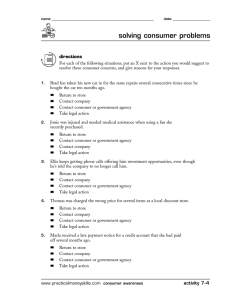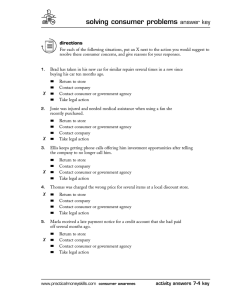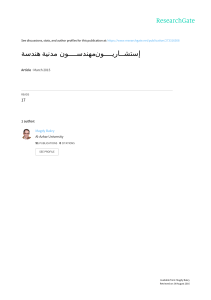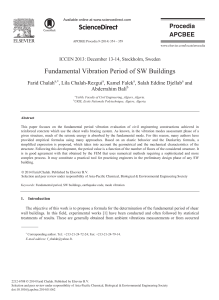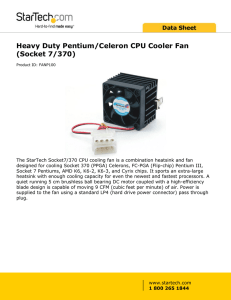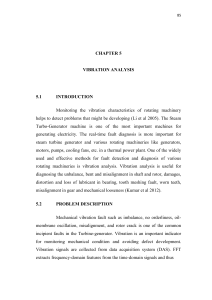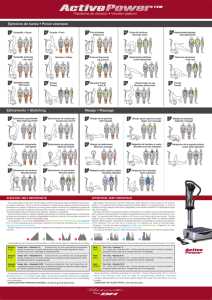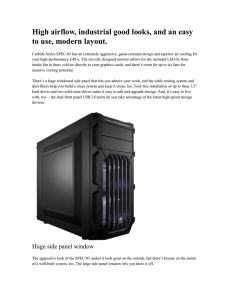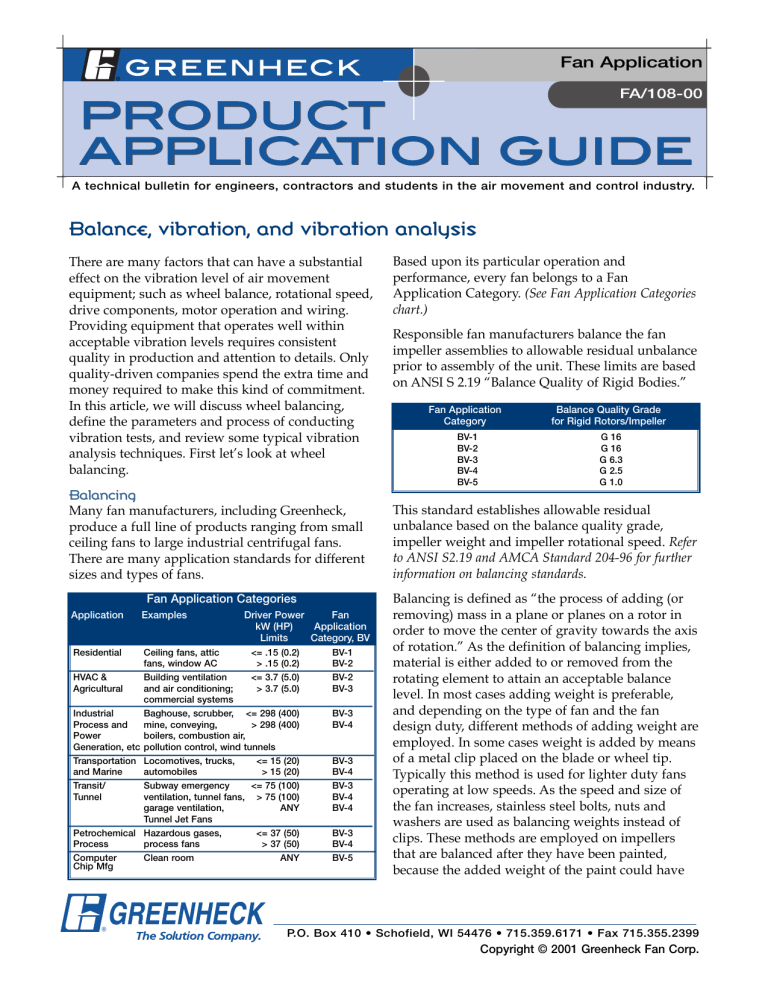
Fan Application ® FA/108-00 product application guide A technical bulletin for engineers, contractors and students in the air movement and control industry. Balance, vibration, and vibration analysis There are many factors that can have a substantial effect on the vibration level of air movement equipment; such as wheel balance, rotational speed, drive components, motor operation and wiring. Providing equipment that operates well within acceptable vibration levels requires consistent quality in production and attention to details. Only quality-driven companies spend the extra time and money required to make this kind of commitment. In this article, we will discuss wheel balancing, define the parameters and process of conducting vibration tests, and review some typical vibration analysis techniques. First letÕs look at wheel balancing. Balancing Many fan manufacturers, including Greenheck, produce a full line of products ranging from small ceiling fans to large industrial centrifugal fans. There are many application standards for different sizes and types of fans. Fan Application Categories Application Residential Examples Driver Power Fan kW (HP) Application Limits Category, BV Ceiling fans, attic <= .15 (0.2) fans, window AC > .15 (0.2) HVAC & Building ventilation <= 3.7 (5.0) Agricultural and air conditioning; > 3.7 (5.0) commercial systems Industrial Baghouse, scrubber, <= 298 (400) Process and mine, conveying, > 298 (400) Power boilers, combustion air, Generation, etc pollution control, wind tunnels Transportation Locomotives, trucks, <= 15 (20) and Marine automobiles > 15 (20) Transit/ Subway emergency <= 75 (100) Tunnel ventilation, tunnel fans, > 75 (100) garage ventilation, ANY Tunnel Jet Fans Petrochemical Hazardous gases, <= 37 (50) Process process fans > 37 (50) Computer Clean room ANY Chip Mfg ® BV-1 BV-2 BV-2 BV-3 BV-3 BV-4 BV-3 BV-4 BV-3 BV-4 BV-4 BV-3 BV-4 BV-5 Based upon its particular operation and performance, every fan belongs to a Fan Application Category. (See Fan Application Categories chart.) Responsible fan manufacturers balance the fan impeller assemblies to allowable residual unbalance prior to assembly of the unit. These limits are based on ANSI S 2.19 ÒBalance Quality of Rigid Bodies.Ó Fan Application Category Balance Quality Grade for Rigid Rotors/Impeller BV-1 BV-2 BV-3 BV-4 BV-5 G 16 G 16 G 6.3 G 2.5 G 1.0 This standard establishes allowable residual unbalance based on the balance quality grade, impeller weight and impeller rotational speed. Refer to ANSI S2.19 and AMCA Standard 204-96 for further information on balancing standards. Balancing is defined as Òthe process of adding (or removing) mass in a plane or planes on a rotor in order to move the center of gravity towards the axis of rotation.Ó As the definition of balancing implies, material is either added to or removed from the rotating element to attain an acceptable balance level. In most cases adding weight is preferable, and depending on the type of fan and the fan design duty, different methods of adding weight are employed. In some cases weight is added by means of a metal clip placed on the blade or wheel tip. Typically this method is used for lighter duty fans operating at low speeds. As the speed and size of the fan increases, stainless steel bolts, nuts and washers are used as balancing weights instead of clips. These methods are employed on impellers that are balanced after they have been painted, because the added weight of the paint could have P.O. Box 410 • Schofield, WI 54476 • 715.359.6171 • Fax 715.355.2399 Copyright © 2001 Greenheck Fan Corp. Greenheck Product Application Guide an effect on the overall balance of the assembly. In other cases where the weight of the paint is negligible compared to the weight of the impeller, metal plates of varying sizes are welded onto the impeller in the appropriate location to attain adequate balance and then the impeller is painted. specification only requires dynamic balancing. Static balancing would be redundant. Vibration Vibration analysis is a cost-effective and useful diagnostic tool to ensure smooth running fans. Smaller units may not be vibration In some cases, notably tested after assembly because the vibratory those units with very energy is much lower and has little impact small unpainted fan on the installation or the life of the fan. rotors weighing less Vibration is defined as Òthe alternating than eight ounces, mechanical motion of an elastic system, residual unbalance can components of which are amplitude, be difficult to frequency and phase.Ó The two determine accurately. components of vibration that fan Therefore, the manufacturers are most concerned with are fabrication process amplitude and frequency. Amplitude alone of these Welding balance plates to a centrifugal defines how far the rotating body moves products must ensure wheel prior to painting. from the center rotating axis, and the (Shown on dynamic balancing stand) that the weight is frequency is the number of distributed equally cycles, or revolutions that occur about the axis of rotation because within a specified time period. these smaller fan rotors do not undergo the same balancing Frequency is most often process. measured in either Hz (cycles per second) or CPM (cycles per It is important to understand the minute). Amplitude can be difference between static and measured in displacement dynamic balancing. (mils), velocity (in/sec), or Static balancing is usually used on acceleration (gÕs). Of these Permanently secured stainless steel bolts, three, velocity is typically used a very thin rotor, like a flywheel, nuts and washers used as balancing where most of the mass lies in a to describe the vibration of a weights after paint single plane. Static balancing does fan because it represents a not require that the rotor rotates. An example of fairly constant level of vibration severity static balancing is a Òbubble balanceÓ on an independent of the fan rpm. A velocity automobile tire. Here the wheel assembly is placed measurement gives a vibration severity description horizontally on a pivot point and weight is added to that can be compared at any rotational speed. In the front of the rim until the wheel is level. contrast, displacement measures the maximum distance of a vibrating body from its neutral Dynamic balancing is used on most rotors where position. This gives a vibration severity description more than one correction plane is required to at only one specific speed and cannot be compared balance the rotor. The rotor must be rotated to detect without measuring across a range of different and correct Òcouple unbalanceÓ where two equal speeds. Acceleration measures amplitude as the unbalance masses are spaced 180 degrees apart at time rate of change of velocity, which again, is not a opposite ends of the rotor. An example of dynamic particularly useful description of vibration severity balancing is a Òspin balanceÓ on an automobile tire. except for some special analysis applications. Here the wheel assembly is rotated and weights are attached to both the front and back of the wheel rim. Vibration Testing When a fan is ready to undergo vibration testing, it A rotor that is dynamically balanced is also is first mounted on the test bed as either a rigidly statically balanced. For this reason, a meaningful supported or a flexibly supported installation. A 2 ® Fan Application No. FA/108-00 Greenheck Product Application Guide rigidly supported system should have a natural frequency above the running speed. (An example of a rigidly mounted fan is one that is mounted directly to a heavy concrete foundation.) A flexibly supported system should have a natural frequency below the running speed. (An example of a flexibly mounted fan is one mounted on spring isolators.) A tri-axial accelerometer is placed on each bearing, which measures the vibration in the horizontal, vertical and axial directions. The vibration is A tri-axial accelerometer measures the velocity amplitude in the measured and horizontal, vertical, and axial recorded as either directions. filter-in or filterout. A filter-in vibration reading is taken only at one frequency, typically the fan rpm. A filter-out vibration reading measures the vibration over a wide frequency range and is calculated as the square root of the sum of the squares of the filter-in readings over that particular frequency range. Once the unit has been prepared for vibration testing, it is operated at the design speed and tested to ensure the unit falls below the maximum allowable vibration. The chart to the right shows maximum allowable vibration corresponding to each appropriate fan application category. At Greenheck, a unit that undergoes vibration Vibration Limits for Tests Conducts in the Factory Values shown are peak velocity, inches/s, Filter-In, at the factory test speed. Fan Application Category BV-1 BV-2 BV-3 BV-4 BV-5 Rigidly Mounted in./s 0.50 0.20 0.15 0.10 0.08 Flexibly Mounted in./s 0.60 0.30 0.20 0.15 0.10 testing does not ship from our facility until the vibration level is within acceptable limits. If the maximum allowable vibration level is exceeded, various balancing and vibration elimination techniques are used to correct the unit. Analysis Examination of a fanÕs vibration signature can reveal possible sources of excessive vibration or vibration peaks. Identifying the specific frequency at which the vibration occurs is one way to begin an analysis. For example, a vibration peak occurring at the fan speed is most likely a sign of wheel unbalance and can most often be remedied with minor trim balancing. A vibration spike that occurs at the motor RPM could be an indication of motor pulley unbalance. A spike at two times the fan RPM could indicate looseness, bearing misalignment or a bent shaft. Other possible sources of vibration, which are not always as easy to distinguish, are those due to external factors such as electrical vibrations (torque pulses that occur at two times the line frequency). Another example would be a vibration spike caused by a bearing fault in the inner ring. This type of spike would occur at a All Greenheck centrifugal, vane axial and industrial fans are vibration-tested prior to shipment. The vibration signature of each fan (shown above) becomes a permanent record with the fan serial number, available to the customer upon request. Fan Application No. FA/108-00 ® 3 Greenheck Product Application Guide frequency that is a function of the bearing geometry and fan speed. Specifications Vibration specifications should be reviewed carefully to identify any special requirements. Special requirements can add significant labor hours and cost to the vibration testing process. It is important to write a meaningful vibration specification that will ensure your system will operate without excessive vibration, but also one that is not so stringent that it is difficult to meet without adding significant cost and time to the project. Following are some recommendations to consider in reviewing or composing a meaningful vibration specification: ¥ Select the appropriate ÒBalance and Vibration Grade.Ó This will not only ensure a smooth-running unit, but will also help to avoid additional time and costs involved with meeting unnecessarily stringent vibration levels. For example, it would not be practical or beneficial to expect a light duty fan to meet the same vibration requirements as a large, heavy-duty industrial unit. ¥ Specify that the vibration testing be conducted at the fan manufacturerÕs shop and not at the job site. Conducting a vibration test at the job site introduces additional variables, which are outside the fan manufacturerÕs control. Guaranteeing job site vibration levels can be very involved and expensive. bearing. Measuring the vibration levels in all three planes and at each of the bearings is important in getting an accurate picture of a heavy duty fanÕs actual vibration levels. Sample Specification Following is a typical specification example for a belt-driven centrifugal fan in Application Category BV-3: ÒWheels shall be dynamically balanced to Balance Quality Grade G6.3 per ANSI S2.19. Each assembled fan shall be test run at the factory at the specified fan RPM. Vibration signatures shall be taken on each fan bearing in the horizontal, vertical, and axial directions. The maximum allowable fan vibration level shall be 0.15 in/sec peak velocity, filter in, at the fan RPM when the fan is rigidly mounted. Summary We have discussed many factors that affect the vibration levels of operating air movement equipment. Clearly it is a complex subject. It should be apparent to the reader that there are numerous factors contributing to the overall vibration level of an assembled fan. One of the main reasons to purchase the Òcomplete package from Greenheck is that the entire assembled unit (including the fan, motor, drives, base, bearings, accessories, etc.) is vibration-tested as a whole and verified as running within allowable vibration limits. ¥ Specify whether the unit is to be rigidly mounted or flexibly mounted to the vibration test stand. A rigidly mounted unit is the standard configuration, and is the only option if the fan is manufactured less motor and drives. A unit can be vibration tested while flexibly mounted upon request if the fan manufacturer is supplying the entire unit, including motor, drives, isolation or isolation and base. ¥ Specify that the readings be measured in velocity amplitude (inches per second, peak) at the design RPM (filter-in). Filter-in readings guarantee a good level of fan construction and reasonable residual fan unbalance. Filter-out readings become more involved and costly due to additional components that have to be controlled to attain the desired vibration level. ¥ Specify that the vibration readings be taken in the horizontal, vertical and axial directions on each fan One less worry With a complete package there are only a few additional external factors that can adversely affect the vibration level of the fan once it is installed at the job site. Purchasing a complete package gives you one less thing to worry about. GREENHECK 4 ¨ P.O. BOX 410 SCHOFIELD, WISCONSIN 54476-0410 PH. 715-359-6171 www.greenheck.com Fan Application No. FA/108-00
